

 The Accurate Reloading Forums
The Accurate Reloading Forums  THE ACCURATE RELOADING.COM FORUMS
THE ACCURATE RELOADING.COM FORUMS  Other Topics
Other Topics  Recipes for Hunters
Recipes for Hunters  "Transylvanian" Goulash
"Transylvanian" GoulashGo  | New  | Find  | Notify  | Tools  | Reply  |  |
| one of us |
"Transylvanian" Goulash Székely Gulyás Székely Gulyás is a true rebel - it is quite interesting in that it breaks all of the traditional "gulyás rules." The dish generally uses pork - rather than the usual beef - sometimes it even uses a combination of meats! Further, it adds sauerkraut (unheard of!), and cream is added to the resulting sauce (scandalous!), making this dish a unique and intriguing exception to the normal gulyás methods that can be found elsewhere in Hungary and throughout Central and Eastern Europe. The dish's non-conformist character extends even further, to its nomenclature; the "Glittering Eye" blog reports:
Wikipedia in Hungary provides some insight on the origins of this dish; the translation is rather clunky, so I will attempt to transcribe and paraphrase it here (no plagiarism intended):
Wiki goes on to assert that the more it is re-heated, the better it will taste. To add to the confusion, there's an anecdotal alternate origin for the dish that can be found by way of a few sources, citing that it is a specialty of Székelyföld, a region in Transylvania that is home to a sub-group of ethnic Hungarians known as the Székely, or “Seklers” - with this as their traditional dish. Maybe, maybe not ~ I do not claim to know. And as if this weren't enough, a very-slightly-modified-but-essentially-the-same version the dish is also very popular in Slovakia, where it is known by yet another name - Szegedinský guláš. The Slovak name seems to imply (to me, at least), that the origins might be thought to lie in Hungary's paprika mecca of Szeged; however, as far as I can tell, no real connection actually exists. In any case, it is delicious, wholesome and wonderful stuff - I cannot stress that enough! It's also very easy, as well. There are many ways of preparing this dish, but all are very similar, with only minor differences. Essentially, pork (sometimes pre-seared, sometimes not) is added to caramelised onions along with paprika - then, sauerkraut is brought to the party and the mixture is simmered or slow-cooked until the pork is tender. Finally, cream (sometimes a cream-and-flour roux) is added, and the dish is served. There's a little more to it than that, but those are the basics. I had the good fortune to prepare this for the first time not long ago, and was absolutely impressed. The recipe came from the Hungarian chapter of my "Cooking of Vienna's Empire" volume of Time-Life's Foods of the World series. I made a couple of very slight modifications in the method I used to prepare it (explained below); the result was outstanding, and highly recommended. Here's the recipe, as written:
During my research, I encountered several recipes for this, all along the same lines with very minor differences; this particular recipe seems to be a bit "Wetter" than some others, but no matter, as you shall see. It provides a wonderful, rich gravy-sauce that makes this an outstanding stew! When I prepared this dish, I made a double batch, since we have a large household and I also wanted leftovers to last through the week; thus, the photos below will show what seems to be a LOT of food ~ trust me, it will not go to waste! As always, I'll open with a shot of "the goods" that are needed to make this: 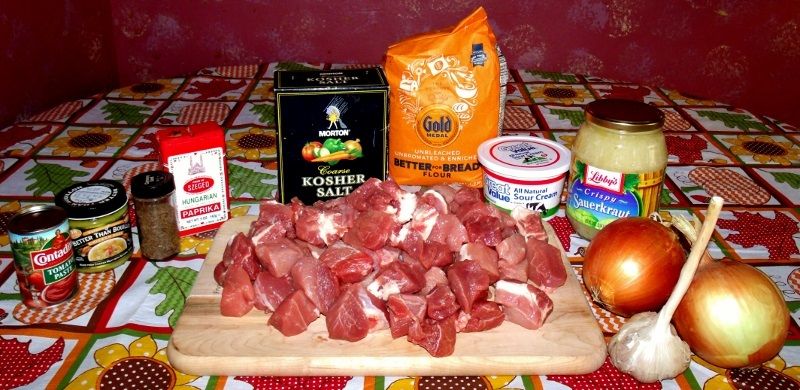 Nothing complicated or exotic here at all, just good, Old-World peasant food that is going to treat you like a king! A note on the cream - my research indicated that there are a few options where this component of the recipe is concerned. In general, one can use sweet cream, and not rinse the sauerkraut - or one can use sour cream and rinse the sauerkraut; one can also employ any combination of sweet, sour, rinsing or not rinsing that one prefers. In my case, I chose to use sour cream and rinse the sauerkraut. To do this, I emptied the jar of fermented cabbage into a strainer: 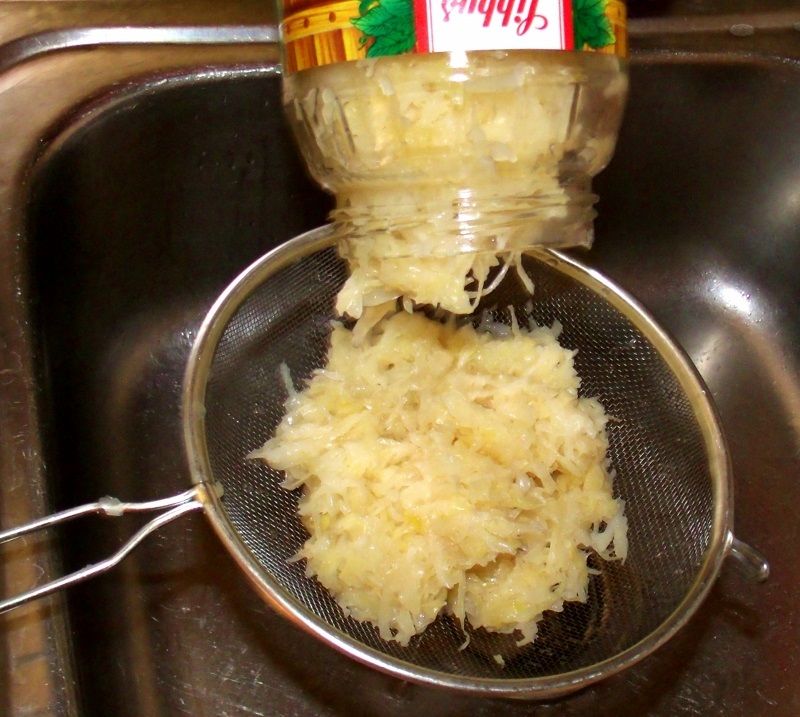 I then rinsed it under cold water for a minute or two, and placed it in a large TupperWare bowl of cold water to soak for a while: 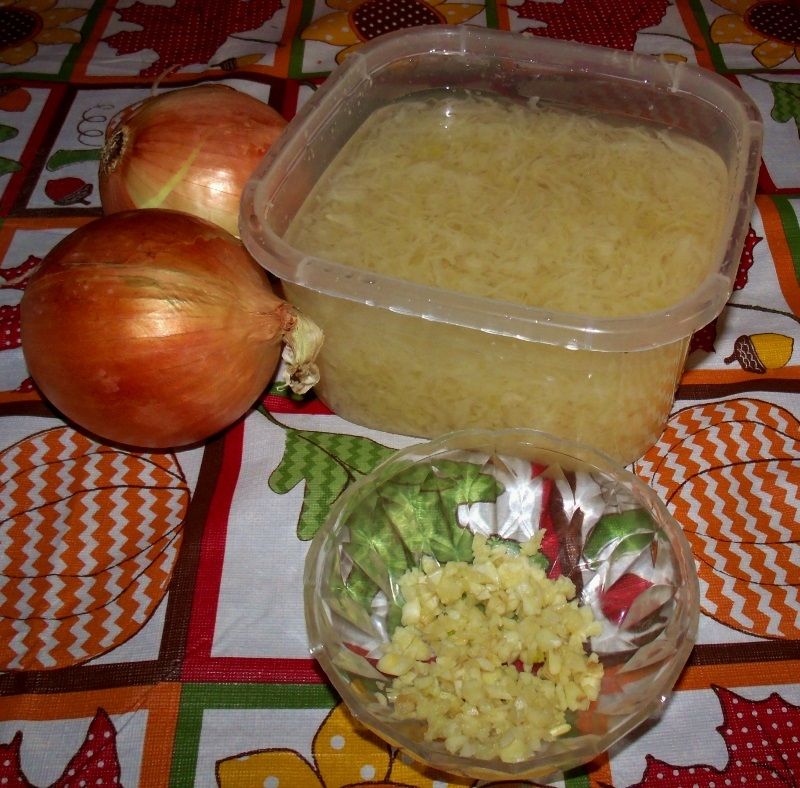 Meanwhile, I minced the garlic (from the photo above, you can see that we used "a little extra") and gave the onions a good chopping: 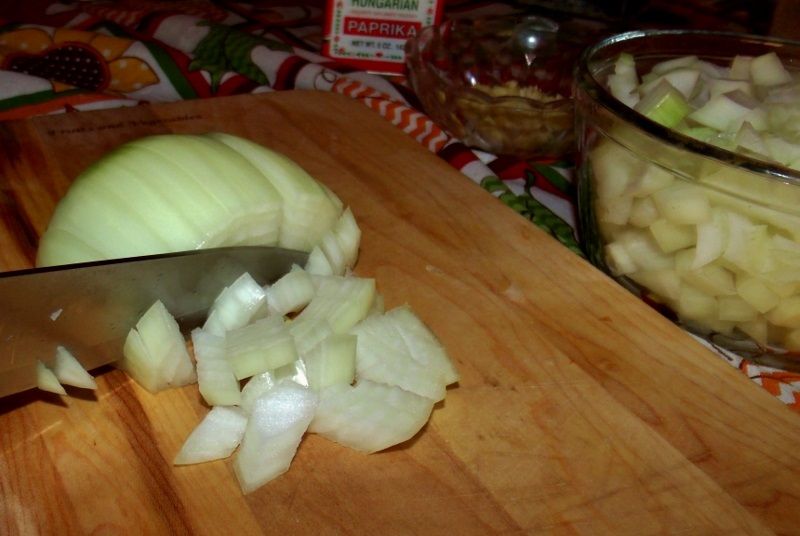 Other than cutting the pork into cubes - which I did prior to taking the photos - my prep work was essentially completed: 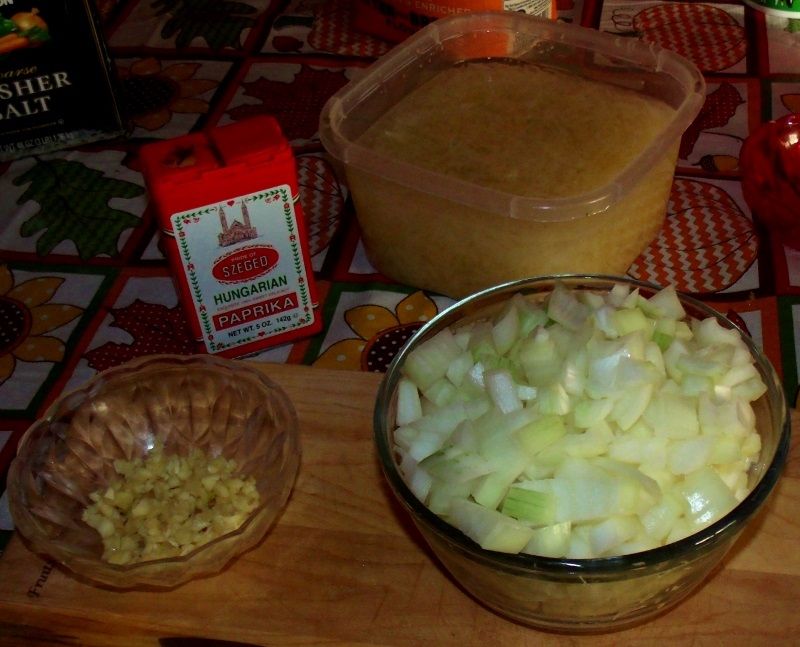 Pork: Hungary is full of it; the farms, the villages, the towns and the cities are all major consuners of it. Hungarian hams, and especially Hungarian sausages, are world famous. Bacon, pork loin, smoked shoulder, head cheese, lard - internal organs are used to make a boudin-like specialty called hurka. A pork stew, called pörkölt , is one of the most widely-eaten dishes throughout the land. Tongues, ears and tails show up in many dishes. Hog-killing time is practically a national holiday - a tradition as old as time itself. In Hungary, the old saying holds true: everything is used except the squeal.... except, it is never used in gulyás ~ breakin' the rules! With that, I gave the pork a moderate seasoning of salt and black pepper, then began searing the cubes in batches in my cast iron Dutch oven: 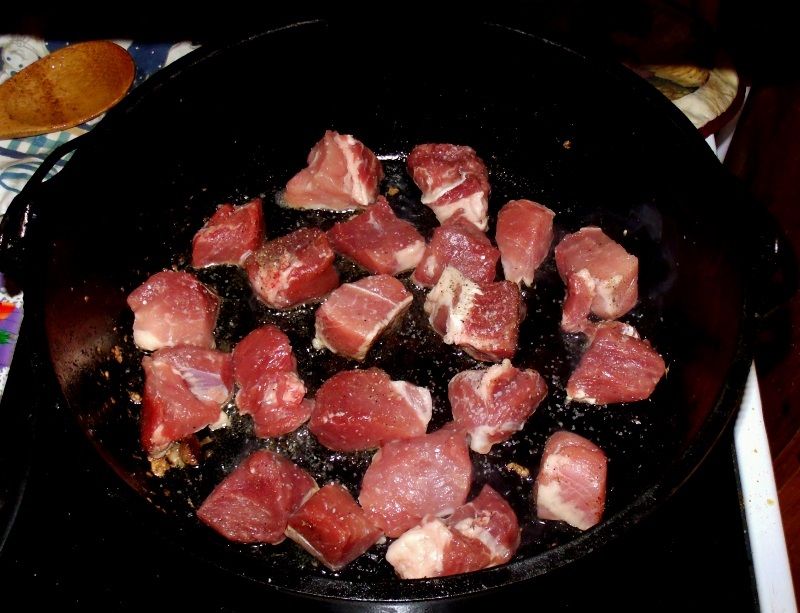 This step is not mentioned in the FotW recipe; it is mentioned in many others that I encountered when I did my research, but not all, so it seems to me to be an optional step. Since I wanted to benefit from the rendered lard and also from the flavour boost that comes from searing meat before cooking, it seemed like a good step to take. Having said that, it is not a necessary step, and you can do this or not as your time and preferences allow. In my case, I was trying to get this into the oven to braise before I went deer hunting south of town; the afternoons go by quickly in northern Montana this time of year, so I ended up rushing this step a bit and the pork chunks probably could have been seared a little better than this: 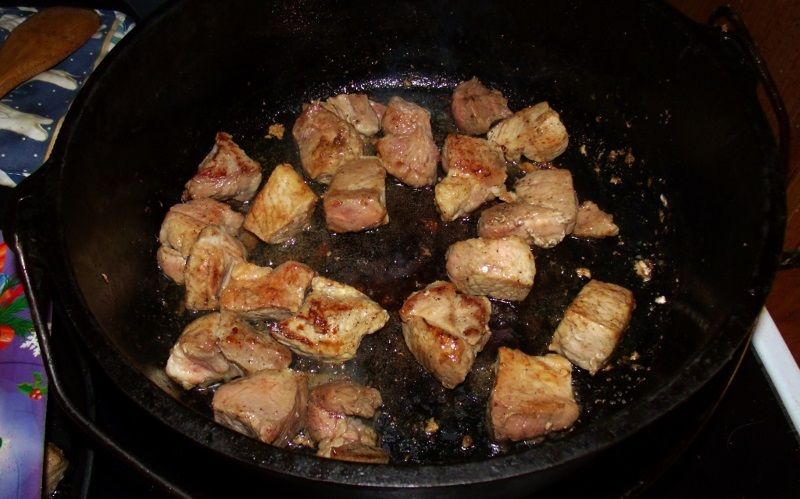 Having said that, I'm glad I did it, because it added a real depth when it came time for the flavours of the dish to get together. You might be thinking to yourself, he's using a non-enameled cast iron Dutch oven for a dish that contains sauerkraut? O! The humanity! The seasoning on his cast iron is going to come right off! Normally, I'd be inclined to worry about this, too - but keep in mind, i had rinsed andn soaked the sauerkraut, and hence, it was an easy decision for me to make, as I like the searing qualities that my un-enameled Dutch oven provides. Speaking of that, once all of my pork chunks were seared, I set them aside, poured off most of the rendered pork fat, and tossed in my onions: 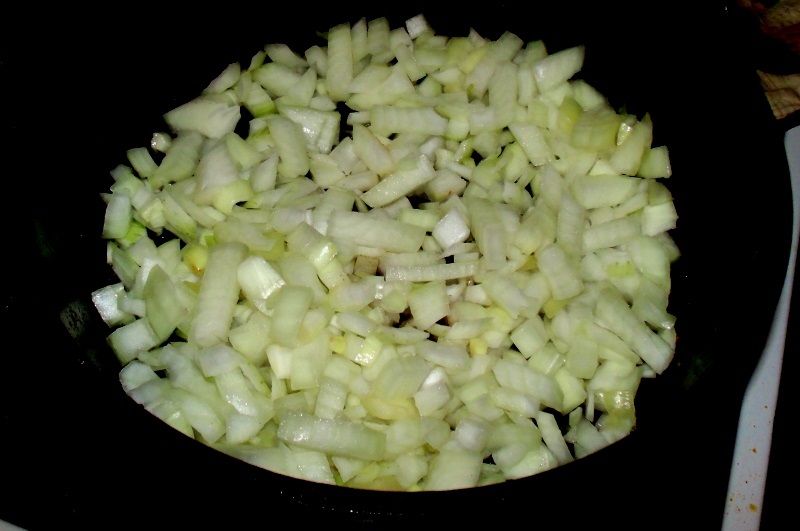 For me, the aroma of onions slowly caramelising in sizzling pork fat will always what Hungarian food is about; it is a unique and enticing aroma that can only be achieved by using pork fat, and while I don't do it often for the obvious reasons, I do indeed use it now and then, when I want a true Hungarian experience. As the onions caramelised and picked up the fond and bits left over from the searing of the pork, the Hungarian essence really started to kick into over-drive: 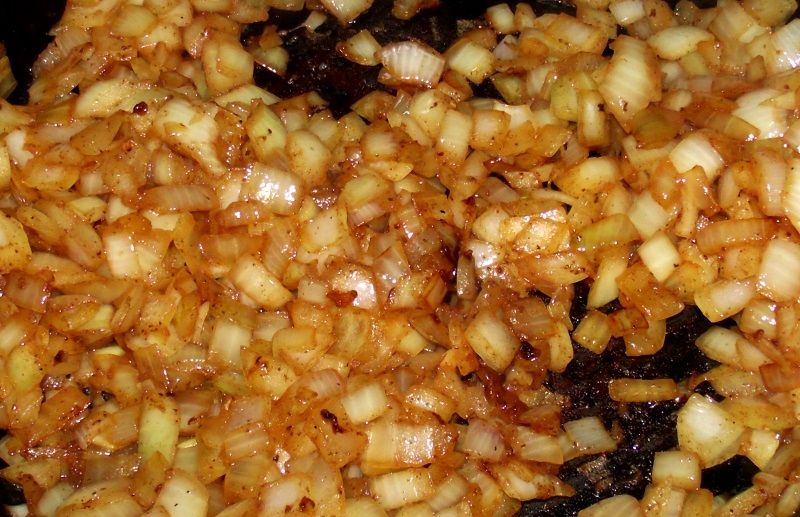 My reading indicates that Hungarian tradition admonishes one to cook the onions in pork fat, slowly, until they just start to brown - the moment before, if possible. Shortly after taking the photo above, I judged them to be at that point, I stirred in the garlic and then and proceeded to shift from Hungarian over-drive... super-sonic. I removed the Dutch oven from the heat and added my Hungarian paprika, stirring it into the onions as it melted into the fats and liquids to form the most beautiful, fragrant, brick-red mess you can imagine:  The removal of the cookware from the heat is an essential step in preparation, otherwise, the paprika is in danger of scorching, which will ruin the flavour of the dish, and perhaps make it gritty. By allowing the quintessentially-Hungarian spice to gently meld into the onions and fat, a foundation is provided that will support the dish right through cooking and to the table....and then to your mouth, where you will find Nirvana. Side note: One subtle, but primary difference between the Hungarian Székely Gulyás and the Slovak Szegedinský guláš seems to be the amount of paprika used; the Slovak uses much less. There might be a couple of other miniscule differences, but other than that, they seem to be the same dish, in spite of the completely different names. During my research, I found an excellent-looking "stove-top" style recipe for Szegedinský guláš on Lubos's Slovak cooking blog: http://www.slovakcooking.com/2...es/segedinsky-gulas/ I intend to give this recipe a try, so that I can juxtapose the two dishes for myself. Back to the Hungarian Székely gulyás! Ready to proceed, I poured in a cup of the chicken stock (remember, this is a double batch):  You can use water, but stock, in my opinion, adds yet another layer of wonderful flavour to the dish; the recipe calls for chicken stock, which I used, but if you have beef or (best of all) a combination of chicken and beef, you will not be disappointed. Next, I added the seared pork back to the Dutch oven: 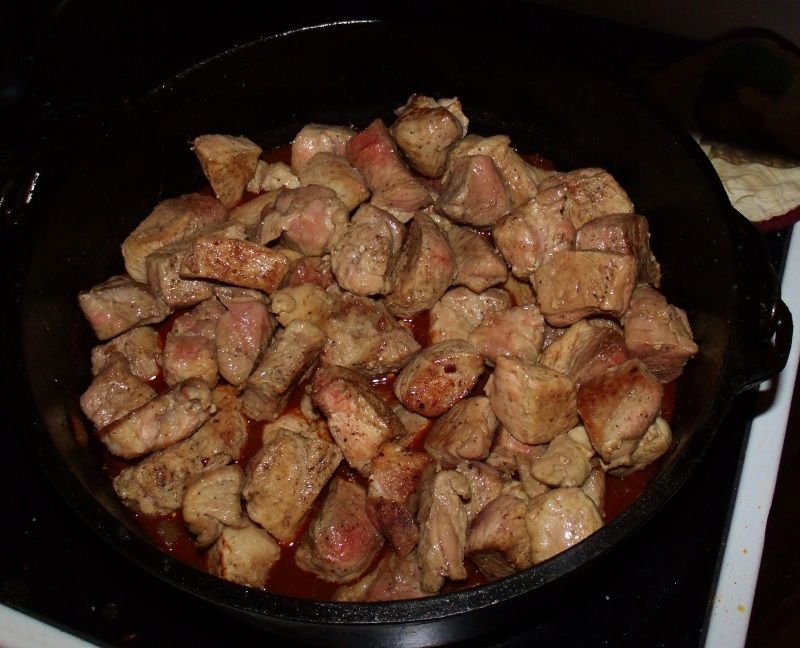 I then spread out the rinsed and drained sauerkraut over the pork, sprinkling the caraway seeds on top: 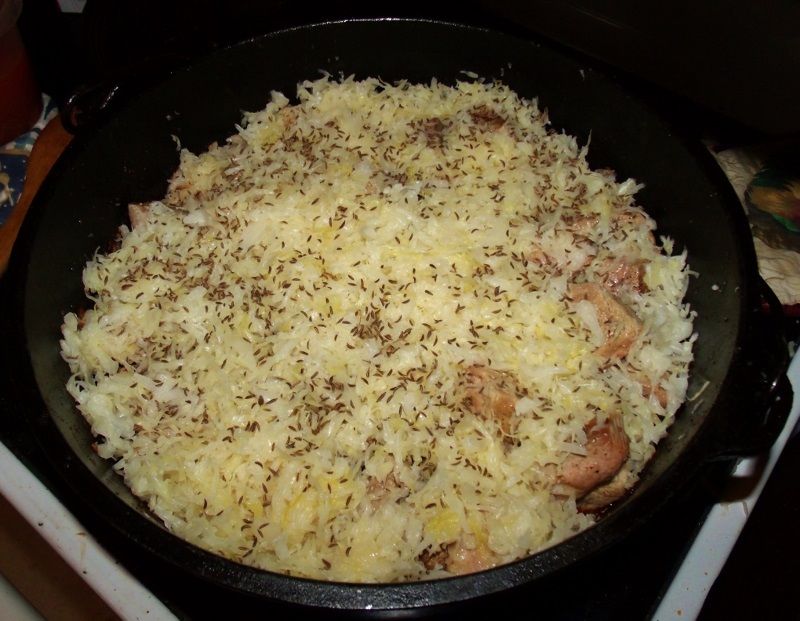 Sauerkraut: fermented cabbage, one of the most common preserved foods in all of Hungary. It can be found either in or alongside countless dishes in every corner of the country, and is beloved by all.... except, it is never used in gulyás ~ breakin' the rules! While we're at it, let's talk for a moment about caraway seeds: In my experience, a person either loves them or hates them; there is no middle ground. I am not the biggest fan in the world where caraway seeds are concerned, but I do like to add a modest amount to Hungarian and other dishes calling for them so that I can get a feel for the authentic experience of tasting and enjoying that dish. In this case, I added the amount called for in the recipe (doubled as per my preparation) - and it was a little much for my taste. I probably would have been better served if I would have halved the amount, but if one enjoys what caraway seeds bring to a dish, then do use the full amount. Moving along, I combined the rest of the stock with some tomato paste and added the resulting mixture to the Dutch oven: 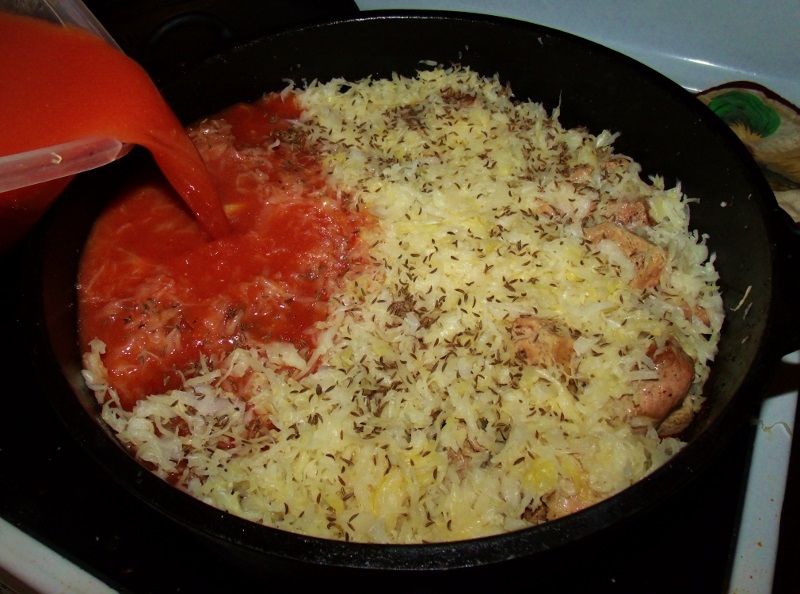 This addition seemed, to me, to be reminiscent of another Transylvanian-style dish that I've made before, the infamous Paprika Hendl, made famous in Bram Stoker's Dracula: http://foodsoftheworld.activeb...hendl_topic1001.html There are a few other similarities that lead me to believe that there are indeed characteristics specific to Transylvanian cuisine that make it regionally unique, even though it spent hundreds of years as part of the Hungarian Empire. Perhaps, Someday, I can take a look at this in more depth.... From this point, the recipe instructs us to simmer the covered gulyás on the stovetop; however, since I was literally on my way out the door to do some hunting, and since I love slow, oven-cooked stews in the Dutch oven, I tossed it in the oven at about 300 degrees to bubble and braise... and become melt-in-your-mouth tender. When I returned from my unsuccessful hunt a couple of hours later, I judged the pork to be fork-tender and proceeded to the final stage of the dish; I grabbed myself some sour cream: 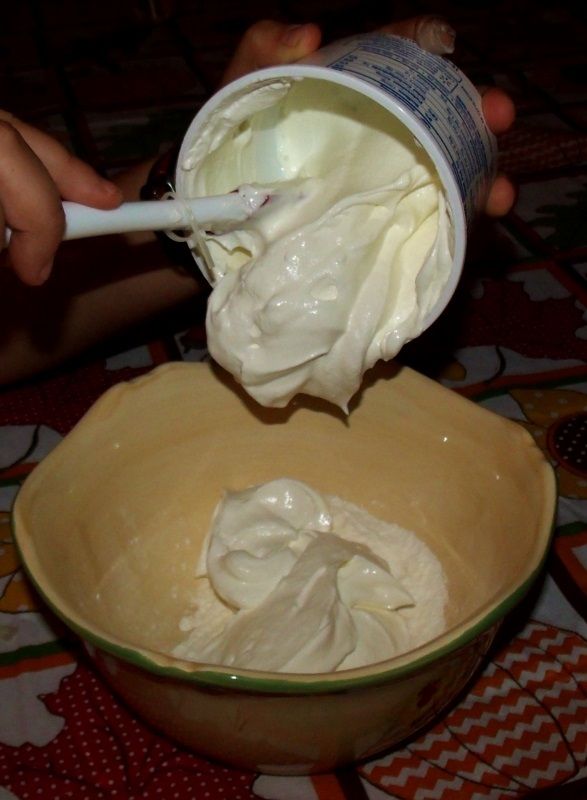 Sour cream - yet another universal element of Hungarian cuisine. I cannot prove it, but I suspect that at least part of its popularity is descended from the usage of yoghurt that the invading Ottomans must have introduced as an integral part of their food habits. Perhaps it was an easy and readily-available alternative to yoghurt; perhaps I am completely wrong. In any case, it is found everywhere in Hungarian cooking, worked into sauces, stirred into vegetables, served as a condiment and used as a topping.... except, it is never used in gulyás ~ breakin' the rules! I whisked the proscribed amount of flour into the sour cream: 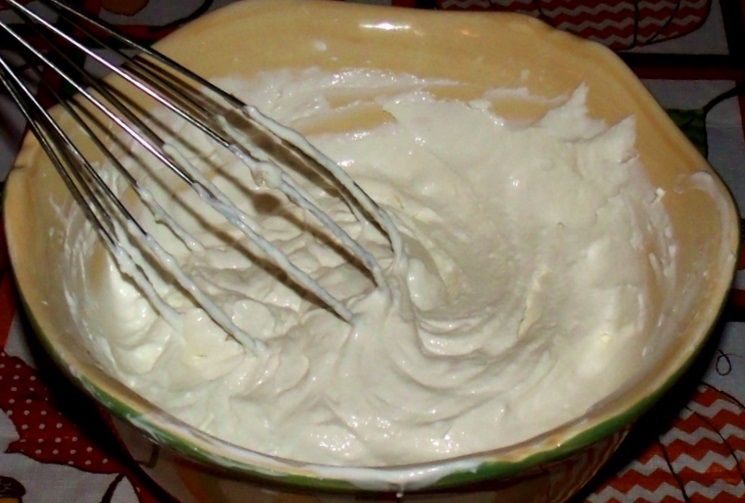 And proceeded to gently fold this mixture into the gulyás: 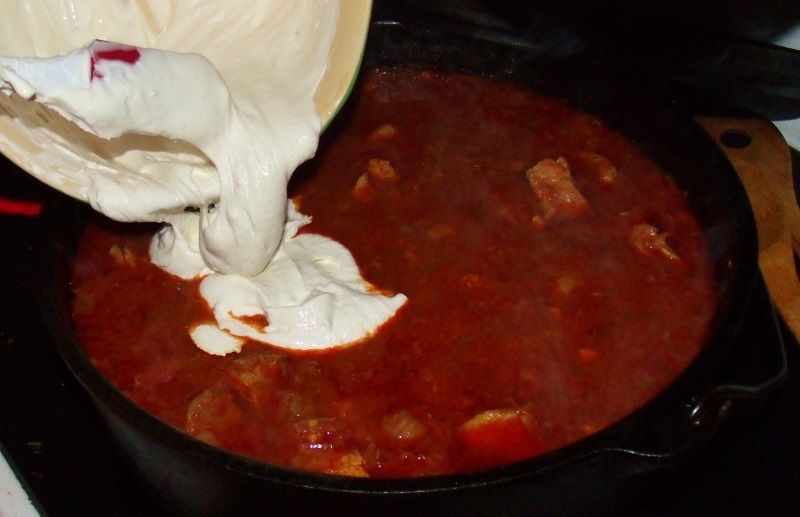 Doesn't that rich, red stew look wonderful??? Considering how easy it was to make, you really should give it a try! As I mentioned above, this recipe seems to result in a "Wetter, more-saucy final product than others that I came across - all the better, in my opinion, for soaking up the nokedli that I made, following Rod's awesome and outstanding pictorial: http://foodsoftheworld.activeb...orial_topic2809.html Thanks to a rare occurrence of good timing, I already had a pot of water just coming to a boil on the stove, so I mixed the nokedli dough-batter according to Rod's instructions and dropped them into the water while the sour cream melted into the gulyás. At this point, I should qualify my experience by saying that I may have made a mistake here; chances are that I probably should have allowed the gulyás to rest a bit and come down from the oven temperatures before adding the sour cream. As it was, it seemed to me that the sauce broke - or the sour cream curdled just a bit - not really affecting the wonderful flavour, but certainly taking a little bit from the appearance of the dish. in any case, once the sour cream is gently incorporated into the sauce, one should continue to gently heat the gulyás at the barest of simmers for 10 minutes or so before serving here we are, gulyás, nokedli and all: 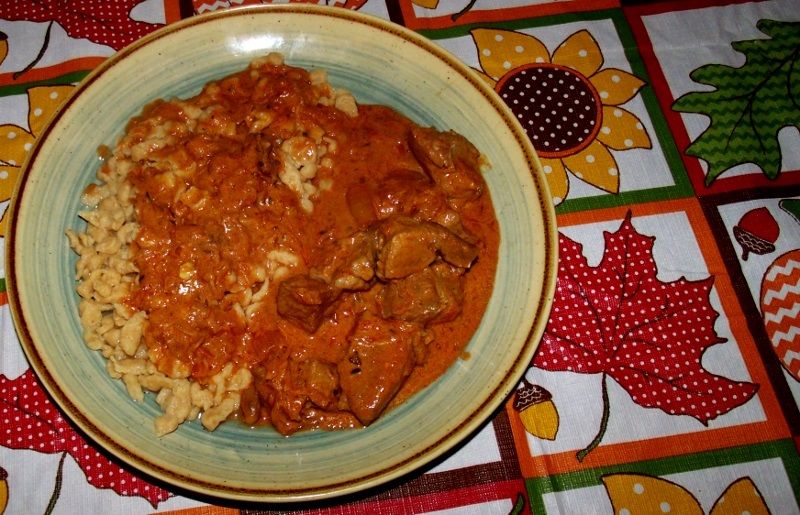 Yes, it does taste as good as it looks! A little bit of green somewhere on the plate might have made for a better formal presentation, but for rustic home-dining with a famished family, this was good enough, and I barely had time to get a couple of photos before everyone dug in. Results, as I have been saying throughout this pictorial, were phenomenal - there aren't too many other words for it. Pork, onions, paprika, sauerkraut and cream might sound a bit unusual "on paper," but "in mouth" they are a true symphony of great tastes and savory deliciousness, with every indication of being one of those perfect dishes in which to wrap yourself on a cold, grey day. This photo is slightly washed out by the flash, but you get the idea: 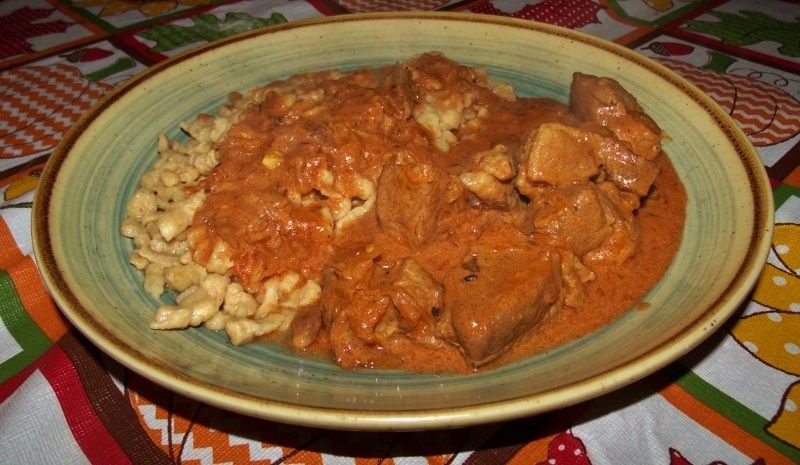 I can't think of any real complaints with this, other than my personal preference regarding the caraway seeds, as mentioned above; as I said before, I would cut the amount in half for myself, but one who likes caraway seeds in their food should add the whole amount without worries. That aside, this was something that I really, really enjoyed, and can heartedly recommend. 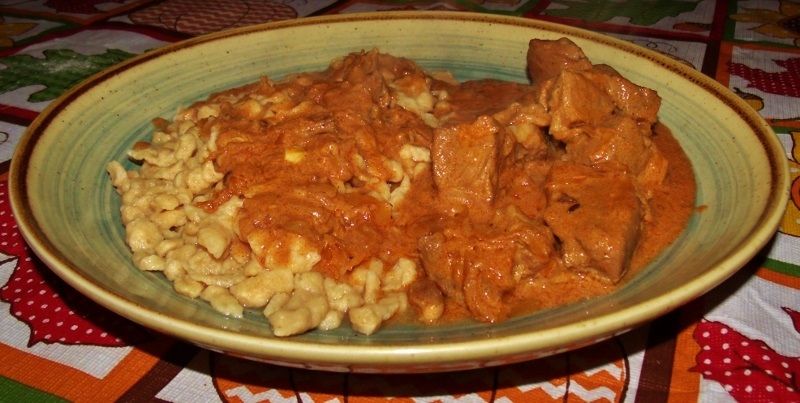 The family all enjoyed this dish as well, and were glad to see that there were a few leftovers for lunch during the upcoming week; unfortunately, I wouldn't be around to try those leftovers, because we spent the week in Montana's state capital of Helena, but when we got home, I noticed that there was no trace of the gulyás left in the refrigerator - all the more reason to make some more, and soon! Thanks for looking, and as always, if you have any questions at all, please let me know. I have a feeling that if you try this rebellious Hungarian specialty, you will love it, no matter what you decide to call it! | ||
|
| one of us |
The dish is rebelous from the start as both paprika [dried ground pepper] and tomato are new world foods .[remember Columbus ?] Of course it all started out with a migrating tribe whose diet was limited .Then it grew as others put in their 2 cents ! Food history is great fun. We now have a restaurant owned by a Hungarian immigrant so I can get gulyas any time I want !! | |||
|
| one of us |
new world transplants, yes - but since the 17th century especially, they have been integral in so much hungarian cooking ~ a perfect match! enjoy that real hunky food, mete - i'm having a hard time finding anything better.... especially this time of year! | |||
|
| One of Us |
Tas: You've been absent and missed. This sounds good. I'll have to try it with our next hog. | |||
|
| one of us |
thanks for the kind words, lavaca. shoulder or similar "non-lean" meat is best; i used boneless "country-style ribs," which are actually from the shoulder/neck region up here. | |||
|
| One of Us |
Tas, probably a dumb question but what is that on the left. Looks like a side or something. Can't tell which ingredient it is. Dumplings maybe? Which would be good with it. Personally I love gulyas. We have a local restaurant that serves it as an appetizer/soup or as an entre. I usually get their cucumber salad too with it. Fresh cucumber slices in a sweet sauce with sour cream on top. I guess it's Hungarian too, but don't know. Anyway, the closest dish we do ourselves to this, we call Venison Stroganoff. You'd like it...it's somewhat similar except no kraut (yet). It does have the sour cream, fresh chopped garlic, a whole basket of fresh mushrooms and plenty of wine... | |||
|
| One of Us |
Damn, that all looks so good! Having been to Hungary, I have enjoyed that dish while in Budapest. But your pics of making it intrigues me! Also, I have been to a couple of Dracula's "hangouts"-one in Budapest where he was imprisoned in a natural series of underground caves or caverns under what is called "Castle Hill", for, I believe, around 10-12 years. The other is Castle Dracula in Romania(the tourist version). Anyway, now that I have digressed. . . . . . . . .! | |||
|
| one of us |
Shack, the 'stuff on the left' is the Germans sneaking in and adding spetzel ! | |||
|
| One of Us |
Hey Tas, our little Deutschen will do that...and with apologies for rusty grammer - Ist das nicht ein Schnitzelbank? Ja, das ist ein Schnitzelbank. Sind sie nicht die Spätzle? Ja, sie sind die Spätzle! | |||
|
| one of us |
thanks for the kind words, gents - it's wonderful stuff, and i now command you all to try it! shack, the side dish is hungarian nokedli, which are pretty much the same thing as german spaetzel. there is a link in the opening post that will show you how easy it is to make them! by the sounds of it, the cucumber salad you had is what they call uborkasalata - i've made it and it's awesome! here's a link: http://foodsoftheworld.activeb...kasalta_topic71.html | |||
|
| One of Us |
hello, i ve seen Gulazs made from combo of pork veal and beef. my family was even doing a mix of beef and brown bear meat. the sauerkraut was added sometimes too. all the best. Phil | |||
|
| One of Us |
i may add it was in Slovenija ... further northern part. | |||
|
| one of us |
it is wonderful stuff for sure, medved - i've been trying different tweaks here and there, exploring my way around with the idea and really enjoying everything. venison gulyas/gulasz on the menu this weekend! | |||
|
| one of us |
I really admire your dedication to culinary adventure. You're as much fun as a barrel of "Good Eats"! "Experience" is the only class you take where the exam comes before the lesson. | |||
|
| One of Us |
Looks delicious.....would it work with venison? | |||
|
| one of us |
Hey, everyone - thanks for the kind words ~ Norton - it would definitely work with venison! I made a similar dish once with venison and it was outstanding ~ | |||
|
| one of us |
It is definitely "the time of year again" for a really good grey-day meal.... | |||
|
| One of Us |
I love Budapest, Hungary but more for the wines and the goose liver and pastries... fat chicks inc. | |||
|
| One of Us |
I just made some for dinner tonight. It's as good as it looks. This recipe seems very forgiving. After browning the meat and onions/garlic, I put everything in the slow cooker for the rest of the day. Caraway seeds cut down to 0.5 teaspoons (about right for me). Then ran out of sour cream and had to add yoghurt to make 1/2 cup. Slow cooker has a very tight seal on the lid, so there was no reduction in liquid. Might be good with mushrooms added (next time). Served over noodles this time. Very similar to "Hungarian baked pork chops" 4-1/2 Star rating. | |||
|
| one of us |
Hey, A/C - very glad that you liked this! Yes, yoghurt should indeed work just as well, as can whipping or table cream. Sour cream is my preference, but any of these are just fine. Agree with you on the caraway seeds, as well. This dish is one of my favourites, and it has been far too long since I've enjoyed it, so I might try it again this weekend. I should have enough pork roast in the freezer to cut into chunks and give it a go. | |||
|
| one of us |
This really is good stuff - unique and very tasty. I made a slightly-modified version a few nights ago, using bits and bobs that I got from trimming off a pork sirloin roast (the really cheap roast where the loin connects to the hindquarter). I shaved off the fat (there wasn't much) and cut it into small pieces/shavings, then cut the meat off the hip bone and into cubes/shavings. Next, I rendered out the fat, leaving the "cracklin's" in the Dutch oven on the stove top. This resulted in just enough rendered fat so that I could cook up a couple of diced onions, sear the pork cubes, and add some garlic, salt, pepper and a butt-load of paprika. Next, I added little stock, a couple of fresh, diced tomatoes and some sliced mushrooms (not in the original recipe, but very much recommended!). I then put the heavy lid back onto the Dutch oven and simmered the beautiful mess for an hour and a half or so. When it was ready to serve, I beat some flour into some sour cream, stirred it in, simmered a little longer (10 or 15 minutes) so that everything could get happy...and voila! I served it over mashed potatoes - the family and I really, really enjoyed it. The only thing that was really missing was the saurkraut. Anyway - extremely good, and easy - I'm hoping that you enjoy it, too, if you try it! __________________ | |||
|
| one of us |
Just the dish to shake off the endless rain. Thanks Tas! There is hope, even when your brain tells you there isn’t. – John Green, author | |||
|
| one of us |
Made it last night. Awesome is too faint praise. Thanks again Tas! There is hope, even when your brain tells you there isn’t. – John Green, author | |||
|
| one of us |
Family's already clamoring for a rerun after Christmas, and I'll get to use my new spätzle maker. There is hope, even when your brain tells you there isn’t. – John Green, author | |||
|
| One of Us |
Funny, it is also popular in Western Czech Republic and its call Zelnacka " Until the day breaks and the nights shadows flee away " Big ivory for my pillow and 2.5% of Neanderthal DNA flowing thru my veins. When I'm ready to go, pack a bag of gunpowder up my ass and strike a fire to my pecker, until I squeal like a boar. Yours truly , Milan The Boarkiller - World according to Milan PS I have big boar on my floor...but it ain't dead, just scared to move... Man should be happy and in good humor until the day he dies... Only fools hope to live forever “ Hávamál” | |||
|
| one of us |
Made this again last night. Still a boffo dish. Thanks Tas! There is hope, even when your brain tells you there isn’t. – John Green, author | |||
|
| one of us |
Bump for a fabulous winter dish! There is hope, even when your brain tells you there isn’t. – John Green, author | |||
|
| one of us |
Thank you, Bill - I'm glad you enjoyed it. | |||
|
| one of us |
Just collected all the "parts" and will make it tomorrow -- with spätzle. Owe you big time for this great recipe, Ron! There is hope, even when your brain tells you there isn’t. – John Green, author | |||
|
| One of Us |
Thanks for resurrecting this old thread! This dish looks beautiful. It's definitely on the slate for this Winter! Doug Wilhelmi NRA Life Member | |||
|
| one of us |
Doug, if you like this one, look up the "halooshkie" recipe! There is hope, even when your brain tells you there isn’t. – John Green, author | |||
|
| Powered by Social Strata |
| Please Wait. Your request is being processed... |
|

Visit our on-line store for AR Memorabilia

